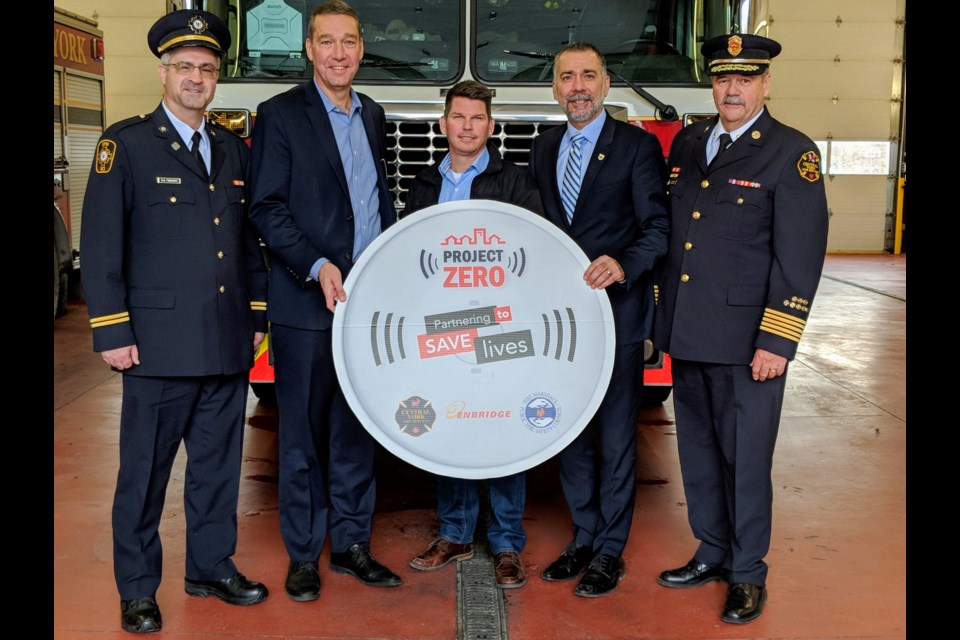On a cold December night 16 years ago, York Region resident Timothy Barlow and his then-wife went to bed early, believing they were coming down with the flu.
Two days later, the couple woke up in hospital to learn they had been unconscious at home in their bed, poisoned by the carbon monoxide that filled their rented house due to a collapsed chimney and bad furnace.
“We were feeling a little off, it was kind of like the flu was coming on and it was getting worse, so we decided to go to bed early,” Barlow said. “Two days later, I woke up in the hospital and remember seeing my mom.”
Barlow’s late mother, Sylvia Hampton, who was a retired nurse, became worried when she couldn’t reach the couple by telephone after two days. She used a spare key to let herself into the home and called 911 immediately after finding them.
“Because we had been unconscious for so long and we were poisoned so badly, we had to go into a hyperbaric (oxygen therapy) chamber four times within 24 hours,” Barlow said. “Later on, I had memories come back from the incident, such as things not making sense. Once the gas takes over, you don’t know you’re in it. You just won’t know what’s going on. It’s not like you’re throwing up, you just don’t feel well. You think you’ve got the flu.”
In hindsight, Barlow said he remembers feeling confused at times, dizzy, and bumped into walls in the weeks leading up to succumbing from the gas that’s known as the silent killer because it can’t be seen, tasted or smelled.
Like a smoke detector, a carbon monoxide alarm is the only way to protect yourself from the deadly threat.
“You can go to sleep and never wake up, and it can happen fast,” Barlow said. “I was told later that if your carbon monoxide alarm goes off, just get out of the house and call the fire department.”
That’s a message Central York Fire Services Fire Chief Ian Laing hopes residents in Newmarket and Aurora hear loud and clear.
“We had 34 incidents of carbon monoxide present in the home last year that could have been deadly, and we were lucky,” Chief Laing told NewmarketToday. “It’s not good to pin your hopes on being lucky, you have to be prepared.”
The local fire service, along with representatives from the Office of the Fire Marshal and Emergency Management, Enbridge Gas, and Newmarket and Aurora councils, were on hand Nov. 13 at the Gorham Street fire hall to accept a donation of 252 combination smoke and carbon monoxide alarms from Enbridge Gas, valued at just more than $15,000.
Those alarms will go to vulnerable residents in Newmarket and Aurora, including seniors and those on a fixed income.
The Enbridge Gas contribution is part of a decade-long public education campaign known as Project Zero that aims to bring fire and carbon monoxide-related deaths down to zero.
Since its inception, Enbridge has distributed more than 44,000 alarms to Ontario fire services at a cost of $1.3 million.
Chief Laing said the local fire service supported new regulations introduced in 2017 that made carbon monoxide alarms mandatory in sleeping areas of every home. Smoke detectors are also required on every level of a house.
“Carbon monoxide can take out a whole family in one night,” Laing said. “We know of a person who worked with us over the years that lost his daughter and grandchildren to a carbon monoxide leak because their chimney was blocked.”
Any fossil fuel when it burns improperly will produce carbon monoxide, Laing said. That includes fuel-burning appliances such as a gas or propane stove or a furnace, wood-burning fireplaces, decorative fireplaces, automobiles, space heaters, and gas or charcoal barbecues.
For example, vehicles left running in an attached garage, a portable generator operating near an open window or in the garage, an outdoor gas barbecue operated inside the house, a kerosene heater not properly vented, a fireplace chimney that is dirty or plugged, all may create unsafe levels of carbon monoxide, according to the fire marshal’s office.
“Anything in the house that generates carbon monoxide can be a danger to people,” Laing said. “It’s critical to have a carbon monoxide alarm in your house so you’re aware if there is carbon monoxide, and you can get out and get medical treatment right away.”
When properly installed and maintained, combination smoke and carbon monoxide alarms help provide an early warning to safely escape from a house fire or carbon monoxide exposure, the fire service says.
Central York fire crews hit the streets every summer and go door-to-door to conduct inspections of alarms, help residents create escape plans, and distribute alarms at no charge.
Local crews visited more than 60,000 residences in the past seven years. In 2018, two student volunteers alone visited 3,500 homes in 10 weeks to check that smoke and carbon monoxide alarms were functioning properly. Of those inspections, 450 required some sort of action to ensure the residents’ safety.
“The biggest thing I can say is that the symptoms of carbon monoxide poisoning are very close to mimicking the flu,” Laing said. “People think, I’ve got a headache, I feel dizzy, nauseated, I’ve got the flu. If you’ve got a carbon monoxide alarm in your house, it’s going to tell you if your carbon monoxide levels are high. We’re running calls all the time to make sure that people are safe and are within the limits. Anything we can do to avoid carbon monoxide poisoning is a win-win.”
Call Central York Fire Services at 905-895-9222 if you have any questions about smoke and carbon monoxide alarms, or if you’d like a home inspection. Visit the service online here.


